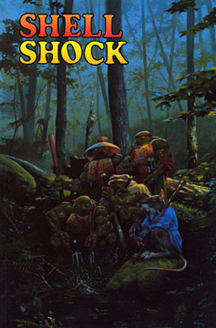During the formative years of the TMNT in the late 1980s, Mirage often reprinted issues when demand warranted it. And those reprints often included what are known as “backup strips,” stories of two to 12 pages that – depending on your point of view – served as an enticement or a thank-you to people for buying a comic a second time.
A majority of these backup strips along with some new ones (for a total of 26) were collected in the 222-page trade paperback “Shell Shock” (1989). You can find a copy on eBay for about $40, maybe less if you are patient. (While that sounds like a lot, it’s much cheaper than tracking down the individual issues these stories are in.)
“Shell Shock” is pure 1980s indie-comic charm, as it lacks page numbers (despite an index listing what page each story is on!), uses a cheesy font for the cover (which otherwise includes a great piece of A.C. Farley art) and strangely doesn’t include the words “Teenage Mutant Ninja Turtles” in the title.

“Shell Shock” (1989)
Collection of 26 short stories (19 reprints, seven originals)
Writers/artists: Kevin Eastman, Peter Laird, Michael Dooney, Eric Talbot, Jim Lawson, Ryan Brown, Michael Zulli, Don Simon
While storytelling is not the strong suit of “Shell Shock” (the page-count of each yarn isn’t enough for a complex plot) it is a treasure trove of art from Eastman, Laird and other Mirage types. And frankly, it’s just fun to spend more time in the world of these characters.
Days in their lives
“Shell Shock” illustrates the mundane aspects of the Turtles lives in much the same way some pre-credits “Buffy” scenes showed Buffy doing her duty slaying vampires. In “City at War” and other stories, the Turtles question whether it was their duty to patrol New York City and stop crime outside of their feud with the Foot Clan.
But many of the best stories in “Shell Shock” show them doing just that. It’s no wonder that they strike up a friendship with Casey Jones; the Turtles, too, are vigilante crime fighters, even if they didn’t want to admit it.
Indeed, in “Night Life” (written by Eastman), the Turtles come upon a black-market drug exchange gone wrong, then they hunt down the killers and string them up from a fire escape – a nice tidy package for the cops. Possibly, that scene inspired the opening of the 1990 movie where the Turtles tie up April’s attackers.
In “Crazy Man” (Eastman), the Turtles come upon a car bomber, track him through the city and presumably secure him for the cops; in a funny punchline, a couple of hoboes get credit for apprehending the bad guy. In “Fun With Guns” (Eastman), Raph and Casey stop local gunrunners.
Why so secretive?
In early TMNT stories, the Turtles often give lip service to the dangers of being seen by police or large groups of people. But when the Turtles’ identities are revealed, more often than not the humans aren’t fazed by it (a prime example is when Casey Jones first meets Raph in the “Raphael” one-shot).

In “New York Ninja” (Eastman and Laird), Donatello helps a young boy – raised as a pacifist — fight off dangerous bullies, and he teaches him the value of self-defense. In “49th Street Stompers” (Eastman), the Turtles agree to a fight with a local mafia: With the Turtles’ victory, the crime syndicate agrees to not move into territory that’s under the Turtles’ protection.
Of course, there’s one day of the year when the Turtles don’t have to worry about being seen. Repeating the notion from “Tales” Issue 3, “Don’t Judge a Book” (Eastman and Laird) finds the Turtles dressing up as themselves for a Halloween party after their costumes are shredded in a fight with would-be robbers at April’s.
Party guests wonder if the Turtles are gremlins, goonies, aliens or characters from “Rambo.” (By the way, it’s nice to see April get invited to a party; she seemed like quite a loner in those early issues.)
Revisiting worlds, timeframes
Sometimes, the writers revisit worlds or timeframes from other stories. “Terror by Transmat” (Eastman) finds the Turtles visiting their pal Fugitoid and the Utroms on the Utrom homeworld. “It’s been … a lot more relaxing than the first time we came here!” Don says. (We’re not told how the Turtles get to the Utrom homeworld, and that’s kind of a big plot hole considering that the TCRI building – and its transmat — blows up at the end of Issue 7).
And in “D’Ants Fever” (Eastman and Laird) — or “Rick’s Dive,” according to the contents page – the Turtles and Fugitoid have a wild time in the alien bar from Issue 5. Was that another vacation, or an expansion of the bar scene from the original arc?
“Meanwhile … in 1,000,000 Years B.C.” (Michael Dooney) is a two-pager set during the time-travel yarn of “Tales” Issue 7, where Mikey decides to mess with future archaeologists by chiseling “Fred loves Wilma” into a stone.
A love of comics, toys
As you can tell, most stories in “Shell Shock” are cases of the writers just having fun and putting their love of comics and movies on paper. In “New Comic Day” (Laird), Mikey gets attacked by his armchair (in a dream) after falling asleep reading comics, and in “Ghouls Night Out” (Eric Talbot), a Turtle (I can’t tell which one!) dreams of being attacked by various monsters after dozing off while watching “Monster Movie Madness.”
“The Road Trip” (Eastman and Laird) finds the Turtles hitching a ride atop a semi and hiking through the woods to get to a drive-in playing “Aliens.” It’s a sweet little love letter to pop culture circa 1986.
In addition to their comic book duties, the Mirage team also contributed toy designs for Playmates, and a few stories here feel like failed pitches. Donatello meets Junk Man in the story of the same name (Dooney), and Casey dons a bullet-absorbing suit made by a guy called Bug Man in “Fun With Guns.” (Although there would later be a Bugman in the cartoon, he is of no relation.)
Neither of those concepts grew into toys, nor did the title characters in “Complete Carnage an’ Radical” (Eastman). But those two at least enjoyed several more appearances; the rival super-mutants’ backstories would be fleshed out in “Tales” Issue 5.
Experiments
Some stories seem like experiments that don’t quite work. Michael Zulli, of “Soul’s Winter” trilogy fame, delivers “O – Deed” and “A Splinter in the Eye of God,” but neither has the resonance of his longer-form work. The biggest “what the heck?” story in “Shell Shock” is “Word Warriors” (Eastman, Laird, Jim Lawson and Ryan Brown), which is nothing more than Leo pulling an Excalibur-style sword from a cement block in a river bottom. Perhaps it served as an inking test for the Mirage team?
Thankfully, “Shell Shock” doesn’t include a lot of extremely goofy stories. “Teen Techno Turtle Trio” (Don Simon) is the only strip that’s brazenly offbeat and non-canonical.
Well, I suppose the opening piece, “Bottoming Out” (Eastman, etc.) is a bit odd. It pitches the Chicago literacy program that got a percentage of “Shell Shock’s” sales by having Splinter give a pep talk to a down-on-his-luck illiterate drunkard. Basically, Splinter serves as the “great mentor.”
Mirage Volume 1 didn’t really earn that archetypal role for Splinter – although the cartoon and movies ran with it – and I always felt a deeper exploration of Splinter’s strengths (taking in orphan turtles and raising them as sons) and flaws (training them to kill for revenge) was warranted.
“Shell Shock” doesn’t give deep insight into any of the characters, but it does open up their world with classic black-and-white NYC streetscape art from E&L and other Mirage staffers.
While not an essential read by any means, serious Turtle fans will certainly get a kick out of it. (For a more detailed look at each of the “Shell Shock” stories, I recommend Mark Pellegrini’s reviews at TMNT Entity.)

